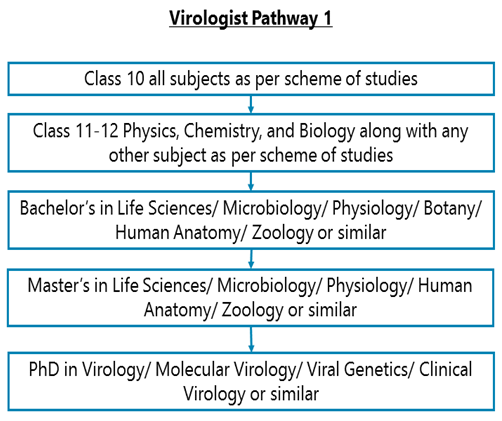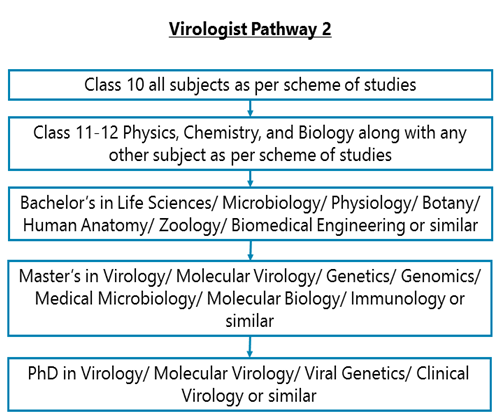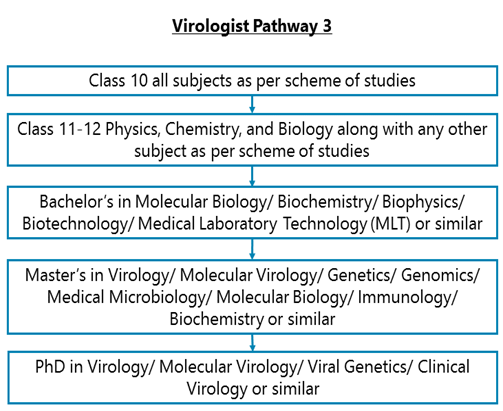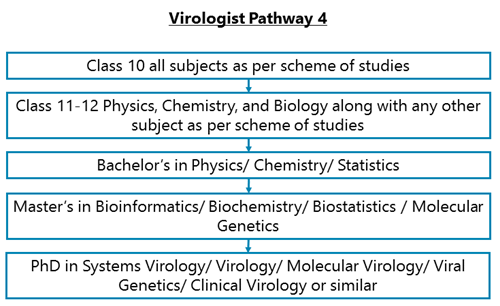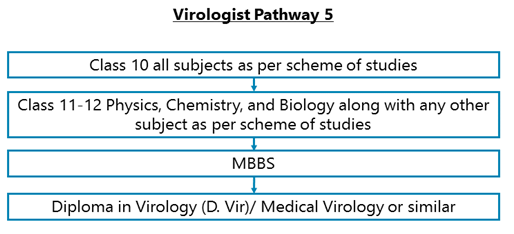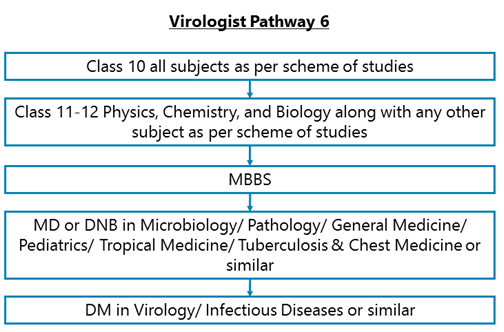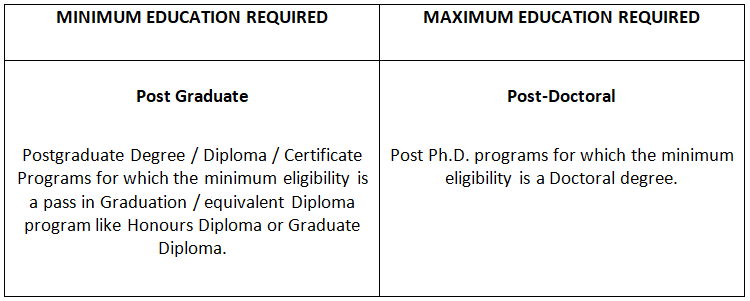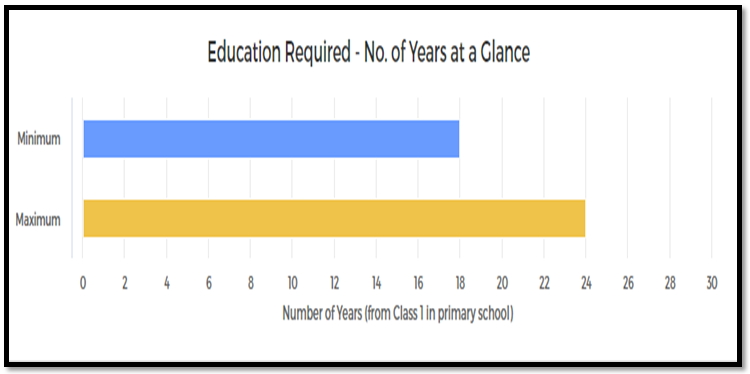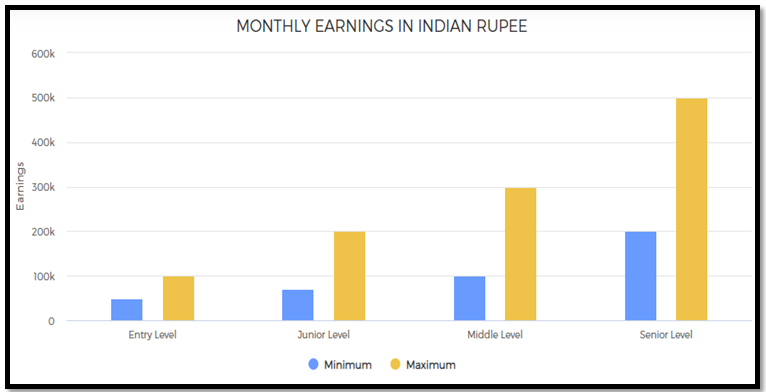Virologist
Entry Level Qualification
Graduate
Career Fields
Mathematics & Science
For Specially Abled






About Career
PARTICULARS | DESCRIPTION |
Name | Virologist |
Purpose | Study Growth, Structure, Development |
Career Field | Mathematics & Science |
Required Entrance Exam | No Entrance Exam |
Average Salary | 150000 - 300000 Rs. Per Year |
Companies For You | Hospital Laboratory/ Medical Research Institute & Many More |
Who is Eligible | Graduate |
Virologists study the structure, growth, development, interactions, pathogenesis and general characteristics of viruses and virus-like agents (etiological agents) such as viroids or prions. Pathogenesis is the study of the causes & spread of diseases inside a host body such as a human, plant or animal body. Viruses or these agents mostly need a host body to reproduce i.e. produce more of their kind to result in disease.
Viruses, viroids, prions, etc. are all types of etiological agents. Etiological agents are the causative agents of a disease condition. They are commonly called pathogens and their interactions inside an infected organism result in pathogenesis.
Viroids are circular nucleic acid molecules which infect plants primarily. These are the smallest infectious pathogens known. Prions are misfolded protein molecules that can exist in a pathogenic conformation (specific structure). These specific structures can result in diseases. All known prion diseases in mammals have no known effective treatment and are always fatal.
The Primary Work of a Virologist
Virologists deal with the classification & evolution of viruses or virus-like agents, their ways to infect & exploit host cells for multiplication (produce more of their kind inside a host for e.g. a human), their interaction with human physiology & immunity, the diseases they can cause, the techniques to isolate & culture them in a laboratory, and their extended use in medical research & therapy.
Virologists conduct investigations into the entire life cycles of viruses inside or outside a host’s body through conventional molecular approaches, assays, experiments, and tests.
In short, Virologists are committed to integrative, all-encompassing studies about viruses and related pathogenic (disease-causing) organisms or molecules. Scientific plural of viruses is “viridae” which means a virus family. For example, the novel coronavirus, that we are so perturbed about today, belongs to “coronaviridae”.
Care to go a little deeper?
Virologists conduct experimental studies to decipher the structure, growth, development, classification & evolution of viruses or virus-like agents. Virologists focus on the morphology & genomic organization of a virus (overall structure & genes in a virus), the various ways a virus interacts with a host cell, the epidemiology of viral infections (the study of incidence, distribution, &possible control of such diseases), the conventional molecular approaches of laboratory diagnosis of the virus in biological specimens of infected patients as well as the prophylaxis (methods of prevention), management & treatment of a viral infection.
Virologists also study virus-like agents or subviraletiological agents which are infectious entities notably smaller & simpler than viruses such as prions and viroids.
Prions can also induce other prions which are non-pathogenic to assume a similar pathogenic conformation and result in diseases. All known prion diseases in mammals affect the structure of the brain or other neural tissue.
Similarly, Virologists may also study viroids which are circular nucleic acid molecules (viroids are RNA, humans have DNA as genetic material). Viroid infections can be transmitted by “aphids” which are small sap-sucking insects like greenflies, blackfly, etc.
Do we know what a virus is?
Well, a virus is not an organism. A virus primarily is only a particle of genetic material (DNA/RNA) encapsulated inside a thick protective protein coat. They do not replicate (reproduce) outside living animals or people. They mostly need a host.
Sometimes, the protein coat may not be there in which case the virus is called “naked”. Viruses are smaller than bacteria. In fact, the largest virus is smaller than the smallest bacterium.
Most viruses can’t survive for more than a few hours outside a host organism which can be a human, plant or animal cell or otherwise even bacterial cells. Yes! Viruses can also infect bacteria for e.g. the class of viruses that are called bacteriophages. Bacteriophages are the most complex of all viruses.
A virus is only a particle of DNA or RNA inside a protective covering.
What is DNA & RNA?
We (humans, animals, plants, even bacteria, fungi, mosses & ferns) all are made up of nucleic acids which are chains of circular rings.
These circular rings are made up of carbon, nitrogen, oxygen, phosphorus and hydrogen atoms. They are the essence of our lives as well as a virus’ life!
To help you understand further, let us recapitulate some basics which you might have studied in Biology in school.
As you know, in a human/animal/plant cell or in any organismic cell, there is a nucleus. In the nucleus, there are chromosomes. A chromosome is basically tightly wound up DNA or Deoxyribonucleic Acid which has the full genetic material or genome of an organism.
Humans/ plants/ animals also have RNA along with DNA in their cells. There can be different types of RNA. The most abundant type is mRNA. mRNA helps DNA to form protein molecules. RNA is not the genetic material in this case.
DNA is the genetic material for humans/ plants/ animals and RNA are just mediator molecules. However, RNA is the genetic material for viruses and most viruses do not have DNA at all. Genetic material means they are converted to protein molecules.
Now, like we said a while back, a chromosome is basically tightly wound up DNA. Viruses do not have chromosomes. They just have a small nucleic acid (RNA) chain which is half of a DNA.
Typically, a DNA is made up of 2 chains whereas an RNA molecule has one chain/ strand generally, that is why half. These are called ss-RNA or single-stranded RNA. Most viruses have ss-RNA inside their protective protein coat.
What is the need of nucleic acids? Why does a virus need a ‘host’ cell to survive?
Now, these nucleic acids(which can be divided into segments called genes) are always being converted to “protein molecules” or messengers, through cell cycles, for all the millions of chemical reactions that take place inside an organism for it to survive, for e.g. to derive energy from the food they eat.
For example, the protective protein covering that we talked about outside coated (non-naked) viruses are also formed from their genetic material which is RNA, through specific genes on the RNA chain.
This nucleic acid to protein conversion can be done in an organism’s body but since the virus is not an organism, it is unable to carry out all the chemical reactions required for survival. So, it needs a “host” cell.
One protein molecule is obtained from one gene on a chain of nucleic acid. It is commonly termed as “coding” i.e. the genes code protein molecules or protein molecules are coded by the genes.
Now, some genes may also be non-coding which means they are not involved in making proteins. Also, all coding genes are not converted simultaneously to protein molecules. This conversion only takes place if & when required and is also governed by the internal pH of the organism.
Key Roles and Responsibilities
1. You will study growth, structure, development, and general characteristics of viral agents like filoviruses, bunyaviruses, arenaviruses, flaviviruses, coronavirus, Zika or related microorganisms to understand their relationship to primarily human health or other applications like agriculture or food technology (through vector-gene modification, etc.).
2. You will demonstrate knowledge of morphology & genomic organization of a virus, the epidemiology of the viral infection, the clinical presentation of the viral illness, conventional molecular approaches of laboratory diagnosis of the virus as well as the prophylaxis (methods of prevention), management & treatment of the infection.
3. You will conduct research studies and investigate viral ecology, pathogenesis, pathophysiology, vector/reservoir transmission, and host immune response to infection from these viral pathogens.
4. You will study the epidemiology of pathogens using newly developed rapid, sensitive, and specific diagnostic-test systems.
5. You will engage in exposing laboratory rodents or non-human primates to viral agents by appropriate means (e.g. intravenous, intramuscular, or via aerosol) to elucidate an acute disease process or evaluate a therapeutic strategy as well as evaluation of the recovery route from the disease.
6. You will examine and understand the basic mechanics of viral evolution and transmission through modeling and experimentation using molecular technologies & reverse genetics.
7. You will design, develop, and implement assays to investigate virus biology, engineer viral vaccines, understand the function of viral envelopes and characterize antibodies against these viruses.
8. You will study the interactions between viral pathogens or viral components and host cells, and develop new antiviral strategies.
9. You will leverage novel findings to advance mitigation strategies to reduce the impact of infectious diseases like Dengue, Zika, Ebola, Coronavirus, Hepatitis C, Chikungunya, and HIV on public health, including the development of medical countermeasures and therapeutic strategies.
10. You will participate in a wide range of research facilitation, laboratory studies, analyses, analytic & computational models, and simulations.
11. You will maintain up-to-date knowledge of pertinent literature, efficiently present results to project team members and develop final study reports for timely publication in peer-reviewed journals.
Career Entry Pathway
Class 10 all subjects as per scheme of studies – Class 11-12 Physics, Chemistry, and Biology along with any other subject as per scheme of studies – Bachelor’s in Life Sciences/ Microbiology/ Physiology/ Botany/ Human Anatomy/ Zoology or similar – Master’s in Life Sciences/ Microbiology/ Physiology/ Human Anatomy/ Zoology or similar – PhD in Virology/ Molecular Virology/ Viral Genetics/ Clinical Virology or similar
After completing Class 11-12 Physics, Chemistry, and Biology along with any other subject as per scheme of studies, go for a Bachelor’s in Life Sciences/ Microbiology/ Physiology/ Botany/ Human Anatomy/ Zoology or similar. Then you can pursue Master’s in Life Sciences/ Microbiology/ Physiology/ Human Anatomy/ Zoology or similar. Thereafter, go for a PhD in Virology/ Molecular Virology/ Viral Genetics/ Clinical Virology or similar areas of study.
Class 10 all subjects as per scheme of studies – Class 11-12 Physics, Chemistry, and Biology along with any other subject as per scheme of studies – Bachelor’s in Life Sciences/ Microbiology/ Physiology/ Botany/ Human Anatomy/ Zoology/ Biomedical Engineering or similar – Master’s in Virology/ Molecular Virology/ Genetics/ Genomics/ Medical Microbiology/ Molecular Biology/ Immunology or similar – PhD in Virology/ Molecular Virology/ Viral Genetics/ Clinical Virology or similar
After completing Class 11-12 Physics, Chemistry, and Biology along with any other subject as per scheme of studies, go for a Bachelor’s in Life Sciences/ Microbiology/ Physiology/ Botany/ Human Anatomy/ Zoology/ Biomedical Engineering or similar. Then go for a Master’s in Virology/ Molecular Virology/ Genetics/ Genomics/ Medical Microbiology/ Molecular Biology/ Immunology or similar. Then go for PhD or doctoral studies in Virology/ Molecular Virology/ Viral Genetics/ Clinical Virology or a closely related field.
Class 10 all subjects as per scheme of studies – Class 11-12 Physics, Chemistry, and Biology along with any other subject as per scheme of studies – Bachelor’s in Molecular Biology/ Biochemistry/ Biophysics/ Biotechnology/ Medical Laboratory Technology (MLT)or similar – Master’s in Virology/ Molecular Virology/ Genetics/ Genomics/ Medical Microbiology/ Molecular Biology/ Immunology/ Biochemistry or similar – PhD in Virology/ Molecular Virology/ Viral Genetics/ Clinical Virology or similar
After completing Class 11-12 Physics, Chemistry, and Biology along with any other subject as per scheme of studies, go for a Bachelor’s in Molecular Biology/ Biochemistry/ Biophysics/ Biotechnology/ Medical Laboratory Technology (MLT) or similar. Then go for a Master’s in Virology/ Genetics/ Genomics/ Medical Microbiology/ Molecular Biology/ Immunology/ Biochemistry or similar. Then go for PhD or doctoral studies in Virology/ Molecular Virology/ Viral Genetics/ Clinical Virology or a closely related field.
Class 10 all subjects as per scheme of studies – Class 11-12 Physics, Chemistry, and Biology along with any other subject as per scheme of studies – Bachelor’s in Physics/ Chemistry/ Statistics – Master’s in Bioinformatics/ Biochemistry/ Biostatistics / Molecular Genetics– PhD in Systems Virology/ Virology/ Molecular Virology/ Viral Genetics/ Clinical Virology or similar
After completing Class 11-12 Physics, Chemistry, and Biology along with any other subject as per scheme of studies, go for a Bachelor’s in Physics/ Chemistry/ Statistics. Then pursue Master’s in Bioinformatics/ Biochemistry/ Biostatistics / Molecular Genetics or similar subjects. Then go for PhD or doctoral studies in Systemic Virology/ Virology/ Molecular Virology/ Viral Genetics/ Clinical Virology or a closely related field.
Class 10 all subjects as per scheme of studies – Class 11-12 Physics, Chemistry, and Biology along with any other subject as per scheme of studies – MBBS – Diploma in Virology (D. Vir)/ Medical Virology or similar
After completing Class 11-12 Physics, Chemistry, and Biology along with any other subject as per scheme of studies, go for MBBS. Then go for a Diploma in Virology (D. Vir) / Medical Virology or similar.
Class 10 all subjects as per scheme of studies – Class 11-12 Physics, Chemistry, and Biology along with any other subject as per scheme of studies – MBBS – MD or DNB in Microbiology/ Pathology/ General Medicine/ Pediatrics/ Tropical Medicine/ Tuberculosis & Chest Medicine or similar – DM in Virology/ Infectious Diseases or similar
After completing Class 11-12 Physics, Chemistry, and Biology along with any other subject as per scheme of studies, go for MBBS degree. Then pursue MD or DNB in Microbiology/ Pathology/ General Medicine/ Pediatrics/ Tropical Medicine/ Tuberculosis & Chest Medicine/ Physiology or similar. Then go for a DM/ FNB in Virology/ Infectious Diseases or similar.
Required Qualification & Competencies
To gain entry into this field, you must clear Class 10 all subjects as per scheme of studies.
Thereafter, you must clear Class 11-12 examinations (higher secondary) Physics, Chemistry and Biology as mandatory subjects along with any other subject as per scheme of studies.
After Class 11-12, you may pursue:
1. Bachelor’s in Life Sciences/ Microbiology/ Physiology/ Human Anatomy/ Zoology or similar
2. Bachelor’s in Molecular Biology/ Biochemistry/ Biophysics or similar
3. Bachelor’s in Physics/ Chemistry/ Statistics
4. MBBS degree
You can study for a Master’s or Doctoral degree in any of the following fields (Note that most colleges will not offer you a degree in these fields at the graduation level, i.e. in Bachelor’s level. These fields are typically for the Master’s or the Doctoral level):
1. Virology
2. Clinical Virology
3. Systems Virology
4. Molecular Virology
5. Cell Biology & Molecular Genetics
6. Microbiology
7. Microbiology & Immunology
8. Vector Engineering
9. Immunotechnology
10. Vaccinology
11. Immunology
12. Viral Pathology
13. Oncolytic Viral Biology
14. Molecular Biology
15. Bioinformatics
16. Viral Cytology
17. Molecular & Translational Medicine
18. Clinical Chemistry
19. Viral Pathogenesis
20. Medical Microbiology
21. Viral Epidemiology
22. Plant Pathology
23. Infectious Diseases
24. RNA/ DNA Biology
25. Pediatric Virology
26. Anatomic Pathology
27. Mucosal Immunology
28. Applied Biostatistics
29. Eco-immunology
30. Medical Virology
31. Applied Plant Virology
32. Clinical Pathology
33. Neuro-bacterio-virology
34. Pathobiology
35. Clinical Microbiology
36. Tumor Virology
37. Tropical Medicine
38. Plant Virology
39. Viral Epidemiology
40. Diagnostic Virology
Compentencies Required
Interests
1. You should have interests in Investigative Occupations. Investigative occupations involve working with ideas and quite a lot of thinking, often abstract or conceptual thinking. These involve learning about facts and figures; involve the use of data analysis, assessment of situations, decision making and problem-solving.
2. You should have interests in Enterprising Occupations. Enterprising occupations involve taking initiatives, initiating actions, and planning to achieve goals, often business goals. These involve gathering resources and leading people to get things done. These require decision making, risk-taking and action orientation.
3. You should have interests in Realistic Occupations. Realistic occupations often involve physical activities for getting things done using various tools and equipment.
Knowledge & Skills
1. You should have knowledge of Biological Sciences –Knowledge of plants and animals, their anatomical structure, cell structure, tissues, physiological functions, evolution, and all other related aspects.
2. You should have Scientific Skills - in using various scientific rules and methods to get things done or solve problems.
3. You should have Technical Skills - using various technologies and technical methods to get things done or solve problems.
4. You should have Quality Control Analysis Skills - conducting tests and inspections of products, services, or processes to evaluate quality or performance.
5. You should have experience working independently under general direction within the scope of an assignment and use sound judgment in determining methods, techniques, and evaluation criteria.
6. You should have Systems Analysis Skills - determining how a system should work and how changes in conditions, operations, or the environment will affect outcomes.
7. You should have enough verbal and written communication skills necessary to effectively collaborate in a team environment and present technical ideas/results.
8. You should have Critical Thinking skills- Skills in the analysis of complex situations, using logic and reasoning to understand the situations and take appropriate actions or make interpretations and inferences.
9. You should have Judgment and Decision Making Skills - considering pros and cons of various decision alternatives; considering costs and benefits; taking appropriate and suitable decisions.
10. You should have Problem Solving Skills - Skills in analysis and understanding of problems, evaluating various options to solve the problems and using the best option to solve the problems.
Technological Knowledg
1. You should have knowledge of techniques and concepts including but not limited to PCR, qPCR, mutagenesis, cloning, aseptic tissue culture techniques, in vivo viral delivery, histology, variety of cloning techniques (restriction enzyme cloning, Gibson Assembly, Golden Gate Assembly, etc.), capsid design, vector optimization/ production, etc.
2. You should have knowledge of scientific and analytical software tools such as ASASI, BLAST, BD Biosciences CellQuest, BD Biosciences CloneCyt, Bruker Optics OPUS, BtB Software Mycobacteriology Lab, Codon Usage Database, Computing Solutions LabSoft LIMS Micro, DM2 Bills of Lading, Find Target, Frame Plot, Gene Finder, Genie Interactive, Net Lims Auto Lims, Pathogen Modeling Program PMP, PHYLIP, PIBWin, PredictProtein, Proscan, Protein Explorer, Prot Scale, STARLIMS, TreeView, Verity Software House ModFit LT and many more.
3. You should have sound knowledge and experience handling instruments and equipment such as centrifuges, calorimeters, cryogenic or liquid nitrogen freezers, DNA sequencers, electroporation cuvettes, freeze dryers or lyopholizers, french presses, high-pressure liquid chromatographs, FTIR spectrometers, ELISA plate readers, scanning electron microscopes, deionized water systems, and X-ray diffractometers.
Ability
1. You should have Deductive Reasoning Ability - apply general rules and common logic to specific problems to produce answers that are logical and make sense. For example, understanding the reasons behind an event or a situation using general rules and common logic.
2. You should have Problem Sensitivity - The ability to tell when something is wrong or is likely to go wrong. It does not involve solving the problem, only recognizing there is a problem.
3. You should have Inductive Reasoning Ability - to combine pieces of information from various sources, concepts, and theories to form general rules or conclusions. For example, analyzing various events or situations to come out with a set of rules or conclusions.
4. You should have Information Ordering Ability - to arrange things or actions in a certain order or pattern according to a specific rule or set of rules (e.g., patterns of numbers, letters, words, pictures, mathematical operations).
5. You should have Oral Comprehension Ability - listen to and understand information and ideas presented through spoken words and sentences.
6. You should have Oral Expression Ability - communicate information and ideas in speaking so others will understand.
7. You should have Fluency of Ideas - The ability to come up with several ideas about a topic (the number of ideas is important, not their quality, correctness, or creativity).
Personality Traits
1. You are always imaginative or in most situations.
2. You are always or mostly careful about your actions and behaviour.
3. You are always or mostly disciplined in your action and behaviour.
4. You can always act independently or could do so in most situations.
5. You always prefer to experience new things and have new experiences, or you mostly do.
6. You are always calm or generally remain calm in most situations.
Career - Job Opportunities & Profiles
You will find opportunities across science & medicine in various arenas such as an education & academic research institution or in a clinical setting (clinical virology postings) like in a hospital laboratory/ medical research institute or in multinational companies for drug discovery & therapeutics (pharmaceutical/biotech) as well.
Medical Virologists are engaged in establishing clinical diagnostic services in various hospitals/centres, especially in the pre-analytical, analytical & post-analytical phases of clinical diagnostic laboratory testing for viral infections.
As a Medical/ Clinical Virologist, you may work in different spheres of the field of medicine including:
1. General medicine
2. Pediatrics (especially for congenital infections, gastroenteritis, viral respiratory infections and exanthems)
3. Neurology
4. Transplant Medicine/ Nephrology (for opportunistic viral infections/ OVIs)
5. Oncology/ Haematology (for opportunistic viral infections/ OVIs)
6. Gastroenterology (especially for viral hepatitis)
7. HIV facilities
8. Ophthalmology (ocular viral infections)
9. Dermatology
10. Community Medicine
Specialisation Tracks In This Career
Virologist (Infectious Diseases)
Infectious Diseases correlate to a major fraction of Virologists working across the globe. Viruses are known to cause familiar infectious diseases such as the pneumonia, common cold, flu, HIV, SARS, smallpox, cholera, dengue, Hepatitis A, influenza, typhoid, yellow fever etc. Virologists dealing with infectious diseases study about the growth, structure, development, pathogenesis and general characteristics of viral agents like filoviruses, bunyaviruses, arenaviruses, flaviviruses, coronavirus, Zika or related microorganisms to understand their relationship with known infectious diseases. Thousands of Virologists are currently engaged in managing the pandemic of COVID-19. Expansive investigations were already in place regarding the coronaviridae (the coronavirus family) but Virologists are still utterly confused with this new version of Corona.
Virologist (Oncolytic Viral Biology)
Oncolytic Viral Biologists are in huge demand today given the prevalence of cancer across the globe. Oncolytic viruses are those which selectively replicate in and kill cancer cells. They are used in cancer therapies. Oncolytic viruses have proven to be naturally cancer-selective and can also be genetically-engineered. They spread within a tumor, without harming normal tissue. OVs are also very effective at inducing immune responses to themselves and to the infected tumor cells.
Systems Virologist
Systems Virologists focus on computational & mathematical analyses, simulations and modeling of complex viral systems (structure - function correlation). This is a field of study that focuses on the complex interactions within a biological system. One of the aims of Systems Virologists is to find out how a viral cell or a viral protein functions within an infected host (say a human) or within itself using techniques of systems biology. This typically involves complicated metabolic networks or cell signaling networks with the participation of hundreds of molecules and atoms.
Viral Vector Engineering
Vector engineering is one of the most prominent fields of applications of virology today. Scientists dealing with viral vector engineering focus on genetic modifications which can be carried out using viral vectors. Vectors are “gene delivery vehicles” which means they carry &deposit gene therapy products to desired locations within a patient’s body. This involves insertion of functional genes into cells to replace faulty or missing genes in order to treat various diseases such as metabolic, cardiovascular, muscular, hematologic, ophthalmologic, as well as infectious diseases. Noveltherapeutic approaches are being developed for neurodegenerative, neuroinflammatory and ophthalmic disorders too. Viral vectors can be based on many types of viruses such as adenovirus, adeno associated virus (AAV), lentivirus, retrovirus, Sendai virus, herpes simplex virus, vaccinia virus, baculovirus and alphavirus.
Viral Epidemiology
Viral Epidemiologists deal with viral outbreak preparedness, investigation, prevention and control. They focus on emerging and re-emerging viruses mostly. They study conventional and molecular epidemiology of viral infections too. They are concerned with biosafety, containment (how to store viruses) and biosecurity (including standard precautions, use for personal protective equipment/ PPE, hospital infection control & biomedical waste management). Vectors of viral diseases (the carriers of a virus i.e. a mosquito in case of dengue) and their control are also studied in depth by Viral Epidemiologists.
Translational & Clinical Virologist
Translational & Clinical Virologists are responsible for pre-analytical, analytical & post-analytical phases of clinical diagnostic laboratory testing for viral infections. They handle specimens of patients, analyze them using conventional molecular assays, interpret results and coordinate with treating physicians regarding possible therapies. They may or may not have a medical degree. They may deal with numerous diseases like viral infections of the skin (including those of children -pediatrics), viral respiratory infections (rhinitis, pharyngitis, bronchiolitis, pneumonia etc.), viral CNS infections (encephalitis, meningitis, acute flaccid paralysis, etc.), viral gastroenteritis (including viruses causing diarrhea), viral hepatitis, viral infections in transplant recipients, congenital viral infections i.e. those present since birth, ocular viral infections (of the eye), oncogenic (cancerous) viral infections, HIV/AIDS etc.
Virologist (Eco-Virology& Behavioral Immunity)
Eco-Virologists, or Ecological Virologists, explore the relationship between the immune system of a human and the viruses in its social, biotic and abiotic environment. A major goal is to understand the pathways that deadly diseases can follow to flow from wildlife to humans. In the last 30 years, more than 300 infectious diseases in humans originated in animals, including Ebola, SARS, hantavirus, AIDS, West Nile virus and new strains of flu (like the novel coronavirus of today). Some Eco-Virologists may also seek to understand and know about the immune systems of wild animals like bighorn sheep, rats, boars, wildebeest, bats etc. instead of genetically similar lab animals, which don’t reflect a real-world scenario. They use such knowledge to gain a better understanding of human immune systems and their susceptibility to viral infections.
Career Growth
For laboratory-based research-related roles, you may join as Molecular Virologist, DNA/RNA Virologist, Production Scientist, Scientist Grade A (to Scientist B / C / D or higher), Infectious Disease Scientist, Scientific Investigator, Research Associate, Scientific Advisor, Postdoctoral Scientist, Research Assistant or Project Officer. You may proceed to higher research-oriented roles like Scientist B / C / D or higher, specifically in the government-funded / aided research institutions or in teaching hospitals & colleges.
1. If you are hired as a research associate, then you will go on to become a Doctoral Research Fellow, then Post-Doctoral Research Fellow in Progressive Grades.
2. If you join the private industry in Research / Scientific or related roles, you may progress to the Senior Level, Lead -> Principal -> Chief levels, and then gradually move on to become Research Director or VP-Strategy, etc.
3. The career growth in university and college begins from Assistant Professor and then Associate Professor, Professor and Professor Emeritus. Professors can also get administrative positions such as Head/Director/Dean/Vice-Chancellor, etc
Salary Offered
1. After a Master’s degree, stipend in India while doing PhD is about Rs. 35,000-38,000 a month in a university or research centre or as a Research Associate with a salary of about Rs. 15,000-20,000 a month.
2. After a Ph.D., a stipend for Post-Doctoral Fellows in a research institution or university research centre is Rs. 40,000-45,000 a month.
In other organizations/companies mostly after a Ph.D. or after a Post-Doctoral Fellowship, salaries in India may vary between Rs. 50,000-1,20,000 a month or even more.
3. After your Ph.D., at entry-level jobs, you may expect to make about Rs. 50,000 – 1,00,000 or even more a month. Higher salaries are paid to graduates from premier institutions or with a medical degree.
4. At junior level jobs, you may expect to get about Rs. 70,000 – 2,00,000 or even more per month.
5. In mid-level jobs in India, may vary from Rs. 1,00,000 – 3,00,000 per month or even more.
6. At a senior level, you may earn about Rs. 2,00,000 –5,00,000 or even more a month. Associate Scientific Directors or Directors of Quantitative Research or VP- Head of Developmental Sciences may earn about Rs. 50,00,000 to 3,00,00,000 or much more per year.
Monthly Earnings In Indian Rupee
1. Entry level: 0 - 2 years of work experience
2. Junior Level: From 1 to 12 years of work experience
3. Mid-Level: From 5 to 20+ years of work experience
4. Senior Level: From 10 to 25+ years of work experience (there could be exceptions in some high-end technical, financial, engineering, creative, management, sports, and other careers; also in the near future, people will reach these levels much faster in many careers and in some careers, these levels will have no meaning as those careers will be completely tech skill driven such as even now, there is almost no level in a Cyber Security Expert’s job)
Work Activities
1. Analysing and interpreting data and information - Analysis of data and information to find facts, trends, reasons behind situations, etc.; interpretation of data to aid in decision making.
2. Communicating with co-workers and others - Communicating with people in writing, verbally or otherwise inside your workplace and various other people who have professional relationships with your place of work including vendors, government officials, etc. or with people at large.
3. Creative thinking - Developing new ideas, concepts, innovative solutions to problems, newer ways of getting things done, designing products and services, creating work of art and craft, etc.
4. Developing and maintaining inter-personal relationships - Developing professional relationships with co-workers and others outside organisations and maintaining good relationships.
5. Getting Information and learning - Observing, hearing, reading, using computers, or otherwise obtaining information and learning from it.
6. Inspecting situations, events, and people - Inspecting situations, events and people to understand the reasons and causes for the situation or events to happen; inspecting people to understand reasons behind their conditions, behaviour and actions.
7. Monitoring processes, systems and performance – Observing and recording information on various criteria to monitor experiments, processes and systems; monitoring progress of projects and tasks.
8. Operating machines, equipment, devices, systems and processes - Using various methods and techniques to operate machines, equipment, devices, systems and processes in laboratory and other settings.
9. Making decisions and solving problems - Analysis of data and information; evaluation of alternative decisions and results of decisions; taking the right decisions and solving problems.
10. Organising, planning and prioritizing tasks - Planning and organising tasks in order to achieve work goals; prioritizing tasks to achieve goals and making the best use of the time available.
11. Processing information - Compiling, tabulating, calculating, auditing, verifying or otherwise dealing with information processing including data entry, transcription, recording, storing and maintaining databases.
12. Scheduling tasks - Scheduling project timelines, tasks and activities.
13. Strategic planning - Developing visions and goals, developing strategies and action plans for achieving visions and goals.
14. Updating and using relevant knowledge - Keeping updated with the latest knowledge relevant to your fields of work and use of the relevant knowledge in getting things done.
15. Using computers for work - Using computers for day-to-day office work; using computer software for various applications in day-to-day professional work; entering data and process information; for writing.
16. Working in a team - Working in a team of people; developing team; maintaining professional relationships among team members.
17. Working with computers, programming and performing technical tasks - Using computers and computer systems, hardware and software for programming, developing software and / or hardware, developing computer applications, systems, and networks; developing mobile applications.
Future Prospects
1. It is safe to predict that this field will remain steadfast in the many years to come, primarily in the immediate future given the current scenario of havoc caused by SARS-COV2 (COVID-19 or Novel Coronavirus). You can also expect a bright, medium to long term future, in this field as the industry prospects are very encouraging and the metrics are progressively rising.
2. Global Antiviral Drug Resistance Market is expected to reach USD 4,573.24 million from USD 2,572.26 million with a growth rate of 6.8% from 2019-2027.
3. The global In-Vitro Diagnostics Infectious Diseases Market size is likely to reach USD 31.45 billion by 2026, experiencing a growth rate of 6.7% compounded annually during 2019 – 2026.
4. Overall, R&D spend from pharma and biotech companies is expected to be USD 177 billion, compared to about USD 171 billion.
5. Biotechnology products are expected to contribute steadily to sales, rising to 52% the top 100 product sales by 2024.
6. The Indian Life Sciences industry will sustain its growth trajectory of 11 to 12% and grow 7 to 8 times to a size of USD 190 billion to 200 billion by 2030.
7. The Global Computational Biology Market was valued at USD 2,327.06 million in 2018 and is estimated to be valued at USD 6,790.06 million in 2024, witnessing a rate of 19.54% compounded annually.
8. The Global Market for Computational Medicine and Drug Discovery Software was estimated to be USD 5.2 billion and is projected to escalate to USD 7.1 billion.
Future Prospects At a Glance


